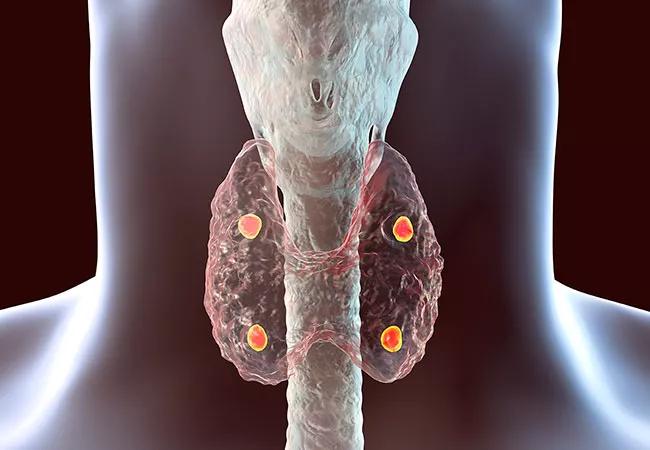A recent study evaluates the correlation between preoperative calcium and parathyroid hormone values as predictors of gland volume and multi-gland disease

Results from a large study from Cleveland Clinic’s Department of Endocrine Surgery suggest a poor correlation between preoperative calcium and parathyroid hormone (PTH) values. These findings come from the largest series to date to evaluate the predictive utility of these values, and the authors suggest that the role of preoperative biochemical values should be diminished in predictive models. The study appeared in Endocrine Practice.
Advertisement
Cleveland Clinic is a non-profit academic medical center. Advertising on our site helps support our mission. We do not endorse non-Cleveland Clinic products or services. Policy
Bilateral neck exploration has traditionally been used to evaluate parathyroid glands for disease in an effort to reduce reoperation, but these surgeries can have serious potential complications including hypoparathyroidism and injury to the recurrent laryngeal nerve. While preoperative imaging techniques have been employed to localize the involved gland or glands, they are not the most accurate tools, especially in multi-gland disease. So, reliance on preoperative localization and intraoperative PTH monitoring has become essential to avoid recurrent or persistent disease.
To assist with this, models have been developed to help surgeons preoperatively predict the state of parathyroid glands. These models usually rely on a combination of preoperative imaging and biochemical values. Previous studies have suggested a potential association between preoperative serum calcium levels and PTH values based on laboratory measurements and parathyroid size. But these correlations were weak and came from limited cohorts.
To better understand the correlation between PTH and preoperative serum calcium levels, the present study evaluated a large, modern cohort to determine the utility of these values in predicting gland involvement at parathyroid exploration. The study included data from 2000 consecutive patients undergoing parathyroidectomy at Cleveland Clinic between 2000 and 2014. Patients were included in the study if they had sporadic primary hyperparathyroidism (PHPT) and underwent initial surgery for parathyroid disease. All patients underwent a four-gland parathyroid exploration with the removal of grossly abnormal—appearing glands based on frozen section analysis. The patients were examined and stratified using the number of involved glands: single adenoma (SA), double adenoma (DA), and hyperplasia (H) if more than two glands were involved. In total, there were 1274 (64%) SA, 359 (18%) DA, and 367 (18%) H cases included in the study.
Advertisement
“Our primary objective with this study was to determine the relationships between preoperative PTH values with the total gland volume of each patient,” explains Allan Siperstein, MD, the Chair of Endocrine Surgery at Cleveland Clinic and the principal author of the study. “We also wanted to determine whether a high or low calcium or PTH value could predict single-gland versus multi-gland disease.”
When looking at a comparison of a preoperative serum calcium and PTH levels (R = 0.37), serum calcium levels and aggregate parathyroid gland volume (R = 0.28), and serum PTH levels and aggregate parathyroid gland volume (R = 0.35), the group found a poor positive correlation. Although a linear relationship was visible among the outliers of the cohort, the majority of the cases with the values most commonly seen in clinical practice showed no correlation. Subgroup analysis for each disease process (SA, DA and H) also showed a weak correlation between serum calcium levels and aggregate parathyroid gland volume, serum PTH levels and aggregate parathyroid gland volume, and serum calcium and PTH levels. The mean total gland volume was similar among all subgroups (SA = 1.28 cm3, DA = 1.43 cm3, and H = 1.27 cm3; P = .52), implying that individual glands were smaller in multi-gland disease.
“The correlation we saw among the outliers demonstrates the value of using larger cohorts,” says Dr. Siperstein. “This study is the largest series to date evaluating the predictive utility of preoperative serum calcium and PTH values. Because of the large nature of this study, we can see that among clinically relevant values, there is no real correlation even though prior research indicated a possible correlation. This should alert parathyroid surgeons that preoperative laboratory testing is not a strong predictor of gland size, and it also does not reliably distinguish between SA, DA and H.”
Advertisement
Advertisement

A reconcilable divorce

A review of the latest evidence about purported side effects

High-volume surgery center can make a difference

Advancements in equipment and technology drive the use of HCL therapy for pregnant women with T1D

Patients spent less time in the hospital and no tumors were missed

A new study shows that an AI-enabled bundled system of sensors and coaching reduced A1C with fewer medications

Association revises criteria for the diagnosis and resolution of severe conditions

Insulin use at time of hospital discharge can offer clues for the future